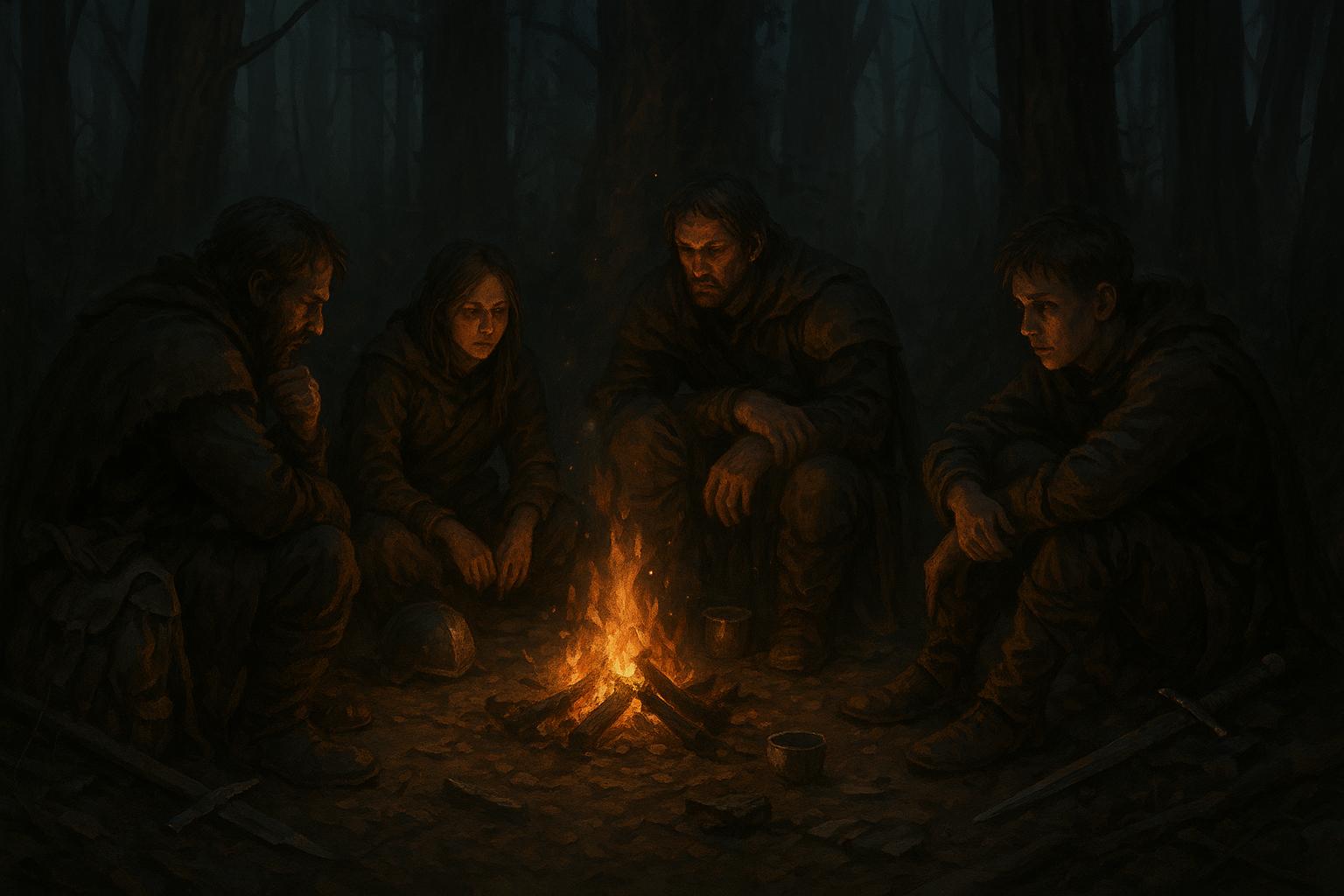Tabletop role-playing games (TTRPGs) thrive on immersive worlds, collaborative storytelling, and creative problem-solving. But what happens when a game introduces a mechanic that shifts the way environments interact with players, making every scene as dynamic as the characters themselves? Enter Daggerheart's environment mechanic, an innovative system that breathes life into exploration, combat, and social encounters alike.
If you’re a game master (GM) looking for tools to spark creativity, enhance your preparation, and bring your worlds to life, this article breaks down why Daggerheart’s environment stat blocks might just be your next favorite feature.
What Is the Daggerheart Environment Mechanic?

At its core, Daggerheart's environment mechanic works like a stat block - but for the world around your players. Instead of focusing solely on adversaries, this system applies game mechanics to areas, moments, or phenomena, giving structure to the challenges and opportunities that come with them. Whether it’s crossing a raging river, navigating a haunted temple, or surviving a cult ritual, these environments are designed to enrich gameplay in a seamless and natural way.
Unlike traditional RPGs, which often leave exploration and world interactions feeling abstract or hand-waved, Daggerheart integrates environments directly into gameplay. This creates tangible stakes, interactive scenes, and dynamic storytelling moments.
Breaking Down the Environment Stat Block
So how does this system actually work? Each environment stat block provides the GM with a toolkit for running a location or event. Let’s explore its key components:
1. Name and Tier of Play
Every environment begins with a name and a tier of play, indicating the intended complexity and challenge level. Daggerheart’s tier structure spans from Tier 1 (Level 1) to Tier 4 (Levels 8-10). The flexibility of these tiers allows GMs to scale environments up or down based on their players’ abilities.
For example, the "Raging River" environment, outlined in the core rulebook, is designed for Tier 1 play. However, the game encourages GMs to adjust environments as needed, providing suggestions for tailoring challenges to higher levels.
2. Environment Type
Each environment is categorized into one of four types:
- Exploration: Mythical or mysterious locations that invite discovery.
- Social: Areas focused on interpersonal or diplomatic challenges, like gala events or tense negotiations.
- Traversal: Physically dangerous locations where movement itself is a challenge (e.g., raging rivers or crumbling cliffs).
- Events: Time-sensitive or action-packed scenarios, such as cult rituals or chaotic battles.
These categories are mix-and-matchable. For instance, the "Raging River" (a traversal environment) could easily overlap with a social encounter if the players are negotiating safe passage across a perilous bridge.
3. Description and Impulses
Descriptions establish a vivid picture of the environment, setting the tone for the scene. But it’s the impulses section that truly shines. Impulses describe how the environment "behaves" or influences those within it, even though it lacks volition or intent.
For example:
- A raging river’s impulse might be to sweep everything away.
- A casino’s impulse could disorient players, tempting them to gamble.
These impulses are a goldmine for inspiration, helping GMs think about how the environment interacts with players and NPCs in organic ways.
4. Difficulty
Each environment also assigns a difficulty - a numerical value players must roll to overcome its challenges. Much like adversary stat blocks, the difficulty serves as a quick reference for GMs, simplifying prep and in-game rulings.
5. Potential Adversaries
To further streamline session prep, environments often include a list of adversaries typically found there. For instance, the "Raging River" suggests beasts like bears and glass snakes or human threats like bandits. This modularity ensures GMs can quickly add depth to encounters without overcomplicating their planning.
6. Features: Actions, Reactions, and Passives
Finally, the real meat of the stat block lies in its features, which dictate what the environment can do. These features are divided into three categories:
- Passives: Always-active effects that shape the scene. For example, the "Raging River" includes a "dangerous crossing" passive that triggers a stress-inducing countdown as players navigate its treacherous waters.
- Actions: Specific challenges or hazards that occur when triggered. In the case of the "Raging River", the "undertow" action can drag unfortunate players downstream, forcing them to react.
- Reactions: Environment-driven responses to player actions or events. For example, spending a GM resource called "fear" could summon a glass snake to threaten the party mid-crossing.
Why Daggerheart's Environment Mechanic Stands Out
1. Bringing Exploration to Life
Exploration is often seen as the "hardest pillar" of TTRPGs to execute effectively. Without clear mechanics, travel and exploration scenes can feel like filler rather than meaningful parts of the story. Daggerheart’s environment stat blocks solve this by turning exploration into an engaging, mechanical experience without bogging it down in unnecessary complexity.
By tying meaningful consequences to the world itself, environments create stakes, tension, and narrative drive for even simple moments like crossing a river or scaling a cliff.
2. Simplifying & Enhancing GM Prep
GMs often face the daunting task of creating compelling encounters from scratch. Daggerheart’s environment blocks don’t just simplify this process - they make it fun. By asking thought-provoking questions and providing actionable mechanics, these blocks help GMs craft memorable scenes with minimal effort.
For example, the "undertow" feature of the "Raging River" block suggests asking:
- Have the players crossed rivers before?
- Are any characters afraid of drowning?
- What treasures might lie at the river’s bottom?
These questions spark creativity, encouraging GMs to tailor the scene to their group while keeping the prep manageable.
3. Scalability and Customization
One of the most impressive aspects of Daggerheart’s environments is their versatility. Whether you’re running a sprawling jungle expedition or a confined dungeon crawl, these blocks can adapt to fit your needs. They can cover large regions or be layered together for heightened complexity - for example, combining a "haunted city" exploration block with a "cult ritual" event block.
Even with only 19 environments in the core rulebook, the system’s adaptability ensures replayability and endless possibilities for customization.
Addressing Concerns: Is It Too Crunchy?
At first glance, Daggerheart’s environment mechanic might seem like it adds extra complexity. But in practice, it’s no more taxing than running a monster encounter. The mechanic is designed to integrate seamlessly into gameplay, with most features triggering only in response to player actions or GM choices.
The emphasis on collaboration and buy-in from players ensures that the system feels fair and engaging rather than disruptive. Once understood, it becomes a natural extension of the game's narrative rhythm.
Key Takeaways
- Dynamic Environments: Daggerheart’s stat blocks turn static locations into interactive, evolving elements of gameplay.
- Four Environment Types: Exploration, social, traversal, and event environments allow for flexible and varied storytelling.
- Impulses and Features: These elements bring environments to life, offering GMs tools to inspire creativity and deepen immersion.
- Scalability: The mechanic is easily adaptable, whether for massive regions or small, layered encounters.
- Enhanced Prep: With clear mechanics and thought-provoking questions, GMs can quickly prepare unique and engaging challenges.
- Collaborative Gameplay: The system thrives on player interaction, making every roll and decision meaningful.
- Perfect for Exploration: It revitalizes one of the hardest aspects of TTRPGs by adding stakes, structure, and excitement.
Conclusion
Daggerheart’s environment mechanic is a breath of fresh air for GMs and players alike. By combining mechanical depth with narrative flexibility, it transforms the way TTRPGs handle exploration, combat, and social encounters. For GMs who want to create immersive worlds without overwhelming prep, these stat blocks are nothing short of transformative.
Whether you're guiding your players across a perilous raging river, through a shadowy jungle, or into the heart of a sinister cult ritual, Daggerheart’s environments provide the framework to turn mundane scenes into unforgettable moments. If you’re looking for a way to make your worlds feel alive, it’s time to let Daggerheart inspire your next adventure. Happy gaming!
Source: "Daggerheart's Environment Mechanic Is Incredible" - Insight Check, YouTube, Aug 11, 2025 - https://www.youtube.com/watch?v=-R-u2g7IMxU


